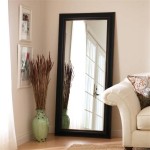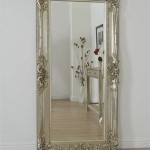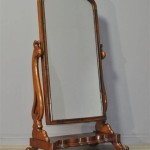```html
How To Hang A Heavy Mirror With D Rings And Wire
Hanging a heavy mirror, especially one equipped with D-rings and wire, requires careful planning and execution to ensure both the mirror's safety and the integrity of the wall. Mirrors are often substantial in weight, and improper installation can lead to damage, injury, or both. This article provides a detailed guide on the procedures and considerations necessary for successfully hanging a heavy mirror utilizing D-rings and wire suspension.
Before initiating the hanging process, a comprehensive assessment of the mirror, its weight, the wall type, and the available tools is crucial. This initial evaluation informs the selection of appropriate hardware and techniques, guaranteeing a secure and aesthetically pleasing installation.
Key Point 1: Preparation and Assessment
The first step involves gathering all necessary materials and tools. These typically include a stud finder, measuring tape, level, pencil, drill, appropriate drill bits (matching the wall anchor type), wall anchors rated for the mirror's weight, heavy-duty picture hanging hooks, safety glasses, and work gloves. The type of wall anchors will depend on the wall type (drywall, plaster, brick, etc.). Consult with hardware store professionals if unsure which anchors are suitable for the specific wall.
Next, determine the mirror's weight. This information is usually found on the mirror's packaging or can be estimated based on its size and material. Knowing the exact weight is critical to selecting appropriately rated wall anchors and hanging hardware. Always err on the side of caution and choose anchors that can support significantly more weight than the mirror's actual weight, ideally exceeding the mirror's weight by at least 25% to 50%.
The wall type must also be identified. Drywall is the most common wall type, but it offers limited weight-bearing capacity without proper support. Plaster walls, while appearing more robust, can be brittle and prone to cracking. Concrete or brick walls offer superior strength but require specialized drilling techniques and hardware. Utilizing a stud finder is essential to locate wall studs. Securing the mirror to a stud provides the most secure and stable hanging solution. If a stud cannot be utilized, appropriate wall anchors are necessary to distribute the weight effectively.
Examine the condition of the D-rings and wire attached to the mirror's frame. Ensure the D-rings are securely fastened to the frame and the wire is in good condition, free from fraying or kinks. If the wire appears worn or damaged, replace it with a new, heavy-duty picture hanging wire rated for the mirror's weight. The wire should be securely looped and fastened through the D-rings, leaving sufficient slack for hanging. Excessive slack can cause the mirror to tilt forward, while insufficient slack can place undue stress on the wire and D-rings.
Determine the desired placement of the mirror on the wall. Use a measuring tape and level to accurately mark the location. Consider factors such as sightlines, furniture placement, and the overall aesthetic of the room. Before making any permanent marks, temporarily hold the mirror against the wall at the intended location to visualize the final result.
Key Point 2: Installation Procedure
With the preparatory steps completed, the actual installation process can begin. If a wall stud has been located, mark its center using the stud finder and a pencil. Drill a pilot hole through the drywall and into the stud at the desired height. The diameter of the pilot hole should be slightly smaller than the screw used to secure the picture hanging hook.
If a wall stud cannot be located, select appropriate wall anchors based on the wall type and the mirror's weight. Follow the manufacturer's instructions for installing the wall anchors. This typically involves drilling a hole in the wall, inserting the anchor, and then securing it in place. Some anchors require specialized tools for installation, so ensure the instructions are carefully reviewed and followed. Once the anchors are installed, attach the heavy-duty picture hanging hooks to the anchors.
Before hanging the mirror, double-check that the hooks are securely fastened to the wall and that the wall anchors are properly installed. Gently test the hooks by applying a small amount of pressure to ensure they can support the mirror's weight. If any movement or instability is detected, reinforce the anchors or select a different hanging location.
Carefully lift the mirror and position it so the wire rests on the hooks. Ensure the weight is evenly distributed across the wire and that the mirror is hanging straight. Use a level to verify the mirror is perfectly vertical. If the mirror is not level, adjust the position of the wire on the hooks until it is. Small adjustments can make a significant difference in the final appearance.
Once the mirror is level, visually inspect the wire and D-rings to ensure they are not under excessive strain. If the wire appears overly taut or the D-rings are bending, the installation may be unstable. Consider using heavier-duty wire or additional support to distribute the weight more effectively.
After the mirror is hung, it's prudent to revisit the security of the installation after a period of time. The weight of the mirror can sometimes cause minor settling or loosening of the hardware over time. Checking the hardware periodically, especially within the first few weeks, can help prevent any unexpected issues.
Key Point 3: Advanced Techniques and Considerations
For extremely heavy mirrors, consider using multiple hooks or a French cleat system for added security. A French cleat is a beveled strip of wood that is attached to both the wall and the back of the mirror, providing a strong and secure interlocking system. This method distributes the weight more evenly across a larger area of the wall, reducing the stress on individual anchors.
When working with older walls, especially those with plaster, extra caution is required. Plaster can be brittle and prone to crumbling, making it difficult to achieve a secure anchor. Consider using specialized plaster anchors designed to grip the wall without causing further damage. Pre-drilling pilot holes is particularly important in plaster walls to prevent cracking. Applying masking tape over the drilling location can also help reduce chipping.
If the mirror is very large or oddly shaped, it may be necessary to use multiple points of attachment to ensure it hangs straight and securely. In this case, carefully measure and level each hanging point to ensure the weight is evenly distributed. Using a laser level can be helpful for achieving precise alignment.
Consider the environment the mirror will be placed in. High-humidity environments, such as bathrooms, can accelerate corrosion of the wire and D-rings. Select rust-resistant hardware specifically designed for high-humidity conditions. Regularly inspect the hardware for signs of corrosion and replace it as needed.
When removing a heavy mirror, always have assistance and take precautions to prevent it from falling. Support the mirror from below while detaching the wire from the hooks. Lower the mirror slowly and carefully to the ground.
Finally, always prioritize safety. Wear safety glasses to protect against debris and work gloves to improve grip and prevent injury. If unsure about any aspect of the installation process, consult with a professional contractor or experienced handyman. Improperly hanging a heavy mirror can have serious consequences, so it's always best to err on the side of caution.
```
Picture Wire Strung Between Two D Rings Attached To The Back Of A Frame Hanging Mirror Heavy Installation

How To Hang A Heavy Mirror Or Picture True Value

How To Install Wire On Back Of Mirror

How To Hang A Heavy Mirror The Home Depot

Hang Your Painting Using Wire And D Rings Picture Hanging Tips Pictures

How To Hang A Heavy Mirror

Making A Mark How To Hang Picture Using D Rings
How To Wire Artwork For Hanging And D Rings Are The Best Hardware A Picture Because They Re Not Only Strong Th

Hang Your Painting Using Wire And D Rings Picture Hanging Tips Frames

How To Hang An Mirror Stockholm Er Bits








